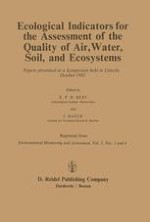1983 | OriginalPaper | Chapter
Taraxacum Species as Environmental Indicators for Grassland Management
Author : P. Oosterveld
Published in: Ecological Indicators for the Assessment of the Quality of Air, Water, Soil, and Ecosystems
Publisher: Springer Netherlands
Included in: Professional Book Archive
Activate our intelligent search to find suitable subject content or patents.
Select sections of text to find matching patents with Artificial Intelligence. powered by
Select sections of text to find additional relevant content using AI-assisted search. powered by
A classification of the microspecies of the genus Taraxacum was made in a range from low to highly dynamic habitats based on qualitative inventories of grasslands under different management conditions. After several years of constant management, a characteristic species composition occurs. Under mowing (hayfield) conditions, dandelions disappear over a period of about twenty years in a sequence where the low-dynamic species T. adamii and T. nordstedtii are the last to vanish. Different microspecies in the section Vulgaria in one field can show small differences in response to environmental conditions, even where no other directly visible indication exists. New appearance of highly dynamic species can indicate disturbance of some kind or other within a relatively short period.The classification adopted seems to be correlated with the phosphate content of the soil. Differences in two easily perceptible morphological characteristics, namely position of the outer bracts and colour of the leaf-stem, fit into the established sequence. Small changes in these characteristics indicate conditions in the field that are improving or worsening from a nature-conservation point of view. A system is introduced in which merely these two morphological characters, without further taxonomical knowledge, can be used for an evaluation of grasslands and the impact of management practice.
